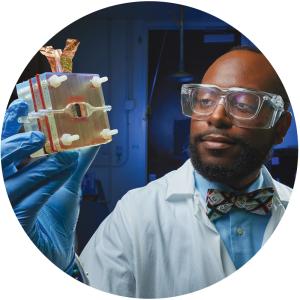Using science and technology to improve national energy security and surety, protect the environment, and understand and mitigate climate change
Laboratory researchers apply leading-edge capabilities to develop efficient and environmentally benign energy technologies and to investigate the processes behind climate change.
Studying Climate Change
In August 2021, the Intergovernmental Panel on Climate Change (IPCC) released the Working Group I portion of IPCC’s Sixth Assessment Report (AR6). Four LLNL scientists contributed to this report, which examines the physical science underpinnings of climate change. Laboratory researchers have been principal contributors and provided scientific leadership in all five previous IPCC assessment reports dating back to 1990. AR6 strongly emphasizes evidence of “unequivocal” human influence on the climate and the occurrence of “widespread and rapid changes” in the biosphere. Multiple, different effects are occurring regionally, and the report provides evidence of those changes to inform risk assessments and adaptation strategies. In FY 2021, studies by LLNL researchers focused on regional changes, for example, the amplification of warming through a reduction in marine clouds and changes in the ecosystem of Sierra Nevada mountain lakes. Livermore scientists and collaborators also made important contributions to reconciling satellite data collected since the late 1970s with model simulations.
Understanding the Carbon Cycle
The terrestrial biosphere removes about 30 percent of the carbon dioxide (CO2) emitted by human activities each year. A Livermore-led research team investigated how this sequestration rate would change at elevated atmospheric CO2 content (eCO2). They synthesized data from more than 100 eCO2 experiments in various ecosystems to assess carbon absorption by the soil. Where plant biomass is weakly stimulated by eCO2 (e.g., grasslands), soil organic carbon (SOC) accumulates. Conversely, SOC declines where the plant biomass is strongly stimulated by eCO2 and mines nutrients from the soil (e.g., forests). These results highlight the need for ecosystem models to include more sophisticated representations of soil nutrient cycling and microbial activity. In another study, LLNL and collaborating researchers found that just a few bacterial groups in ecosystems across the planet are responsible for more than half the carbon cycling in soils. Gaining a better understanding of how individual organisms contribute to carbon cycling has important implications for managing soil fertility to reduce climate change.
Converting CO2 to Useful Products
Combining additive manufacturing with multiscale computer modeling, Livermore researchers are rapidly cycling the design and testing of modular electrochemical reactors with enhanced performance. The versatility and precise control offered by 3D printing makes it possible to tailor reactors to specific operating environments. The Laboratory’s innovative work aims to transform the way many carbon-based products are manufactured. Reactors are used to convert CO2 into hydrocarbons that are valuable industrial feedstocks. Compared to larger thermochemical systems now widely used by industry, the 3D-printed electrochemical reactors are much smaller and operate at ambient temperature and low pressure, making them more energy efficient and less expensive to produce and operate.
Guided by multiscale models that span atomic to continuum levels, Laboratory teams are also designing and 3D printing flow-through electrodes (FTEs) from graphene aerogels. The researchers can precisely tailor the flow in FTEs and the 3D microstructure (e.g., individual grains and crystal facets) of the metal catalysts to optimize performance.
A Switch to Reduce Global CO2 Emissions
Laboratory engineers and collaborators developed a light-activated switch that, if fully deployed, could reduce carbon emissions by more than 10 percent. The device, called the Optical Transconductance Varistor (OTV), is especially well suited for energy grid applications. It is capable of sending high-voltage, direct-current power along grid lines and switching high voltages up to 10 times faster than today’s solid-state devices, a feature that could cut energy losses in half to save 1 billion kilowatt-hours of electricity per year. If widely adopted for the grid, the OTV device could eliminate 750 million tons of greenhouse gases annually by 2050. The LLNL-patented technology is being commercialized by Opcondys Inc., based in Manteca, California. The OTV team won an R&D 100 Award in 2021.
Carbon Neutrality in California
In March 2021, Laboratory researchers released Permitting Carbon Capture & Storage Projects in California—after the 2020 groundbreaking study Getting to Neutral: Options for Negative Carbon Emissions in California, in which LLNL scientists identified a robust suite of technologies to help California become carbon neutral by 2045. The report issued in 2020 assesses the advanced carbon reduction technologies now available as well as the tradeoffs necessary to reach the state’s decarbonization goal. Concerted efforts in carbon capture and storage (CCS) are needed to achieve this objective. The follow-on study focuses on CCS projects in the context of California’s rigorous and robust regulatory framework, which aims to protect the environment, public health, and safety. However, this framework may not be agile enough to handle timely permitting and deployment of enough CCS projects to reach the state’s climate goals. Both studies serve as valuable resources for policymakers, government entities, interest groups, academia, and industry as California starts to address the carbon-neutrality challenge.
Storing Renewable Electricity
With support from DOE’s Technology Commercialization Fund, LLNL researchers and industrial partners are developing an electrobioreactor. When electrical supply exceeds demand, the device can store excess renewable electricity in chemical bonds as renewable natural gas. The team’s electrobioreactor uses the renewable electricity to convert water into hydrogen and oxygen. Microbes then use the hydrogen to convert CO2 into storable methane, which is a major component of natural gas.








